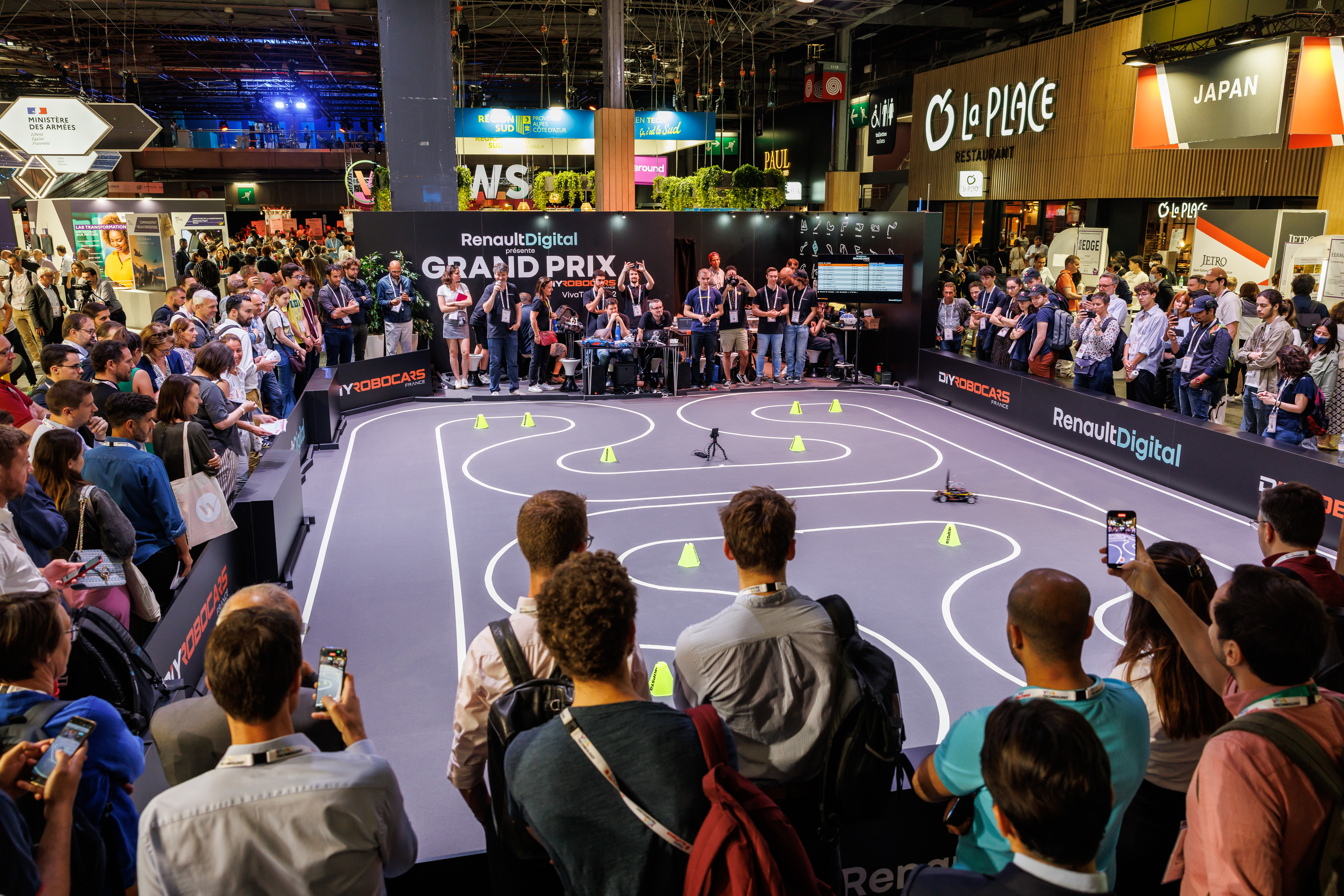Pressiteade

[RF1]You have to admit that, if you mix electronics,coding, development, artificial intelligence, machine learning* and self-drivingscale-model cars, you have a crowd-puller. And that’s what happened on andaround the tracks during the two-day event. It didn’t just thrill the audience:the participants thoroughly enjoyed the fun atmosphere, learning opportunityand camaraderie.
Cars learningto drive themselves
Fun,learning and camaraderie was exactly what Renault Digital had in mind when it organisedthis DIY Robocars France-Grand Prix Renault Digital.[RF2]There wasalso a plentiful variety of pilot. “There were employees, professionalsoftware coders, student engineers, people from all sorts of backgroundscompeting. That’s what makes Robocars so exciting: seeing so many differentangles to reach the same goal: making a car completely autonomous,” saysOlivier Bourrassé, Deputy Head of Technology at Renault Digital and the race’sorganiser.
Thevehicles were off-the-shelf remote-controlled cars, with added-on cameras andsensors. A few months ago, the teams remote-controlled their cars around thecircuit to start the training process. Then their job was to develop the bestalgorithms and tap into artificial intelligence and machine learning to processthe data from the sensors and make the cars more and more autonomous over time.Until they knew the circuit by heart, so to speak, and could negotiate it asfast as possible without cutting corners or toppling the cones demarcating it. “Atournament like Robocars is an opportunity for contenders learn more aboutartificial intelligence, and for spectators and the general public understandit better, or at least demystify it,” Olivier Bourrassé continues.
Afriendly atmosphere and helping each other out
They wereall shooting for the same target, but each team approached it from a differentangle, depending on the challenge it had set itself for the race. They workedon the hardware – using different sensors and cameras – and the technical side.For example, the Alpine 1-Autopylot car developed by Alexandre, Mickaël, MaximeE et Maxime G, four first-year students at EPITA, had larger tyres, so its roadgrip was tighter and it negotiated bends more effectively, but the team had toremove the car body.
Thecompetition was very friendly and everyone was clearly having a lot of fun. Theteams had known each other for several months at that point, and helped oneanother out more than once. They were constantly chatting via an onlinemessaging app among themselves, with the organisers and with enthusiasts. “Thegoal for the tournament, more than anything else, was to get all the cars towork properly. We all had trouble with one thing or another. We help each otherout a lot; we don’t keep any of our development secrets.” says Cyrille, the“driver” of the Fous du Volant car.
Embed tweethttps://twitter.com/RenaultDigital_/status/1538195516005163008
Caption: TheAutopylot team of first-year students at EPITA won the tournament.
Even the fanshelped out. One of the trials called “Catch a Robocar” was a race between anautonomous car and a car that a member of the audience drove with a remotecontrol and immersive vision headset. At least in the event we watched, thehuman won against the machine.
Buildingbonds
Having fun,learning and sharing: the contenders unanimously agree that they did all threeat this tournament. And more than that: working in the conditions provided anopportunity to expand their technical culture, sharpen their skills and learnfrom the experience that Renault Digital’s teams have gathered in artificialintelligence and other cutting-edge disciplines.
“It wasa school project at first, but then a real group of friends started comingtogether around it. We have learnt a lot about artificial intelligence, from atechnical standpoint especially,” reports Maxime, from EPITA.
While theywere fine-tuning their cars, they also started building a network of contacts inthe company. Some of the students are now thinking about starting their careerat Renault Group.
This kindof playing field for tech enthusiasts is a “magnet” for talent and RenaultGroup is naturally excited that the students taking part in this tournament arestarting to consider their options in the professional world. Renault Group CEOLuca de Meo, who was at the Renault Digital DIY Robocars France stand onFriday, made that point: “We have a very important retraining challengein-house but we also need to bring in new blood from schools and universities.We need initiatives everywhere that show that changing our culture at Renaultalso include integrating young people. This is very important to me.”
* Afield of artificial technology that can analyse data sets to learn and improve itsperformance.
Kõik sellel veebilehel olevad materjalid (sealhulgas, kuid mitte ainult: tekstid, fotod, graafika, helifailid, animatsioonifailid, videofailid ja nende paigutus veebilehel) on Renault SASi ja/või selle sidusettevõtete või kolmandate isikute omand, kes on volitanud Renault SASi nende piiratud kasutamiseks, ning on kaitstud autoriõiguse ja muude intellektuaalomandi kohta kehtivate õigusnormidega. Eespool nimetatud materjalide kasutamine muudel kui toimetuslikel eesmärkidel, eelkõige turundus- või reklaamieesmärkidel, on rangelt keelatud.
.jpg) The Robocars autonomous car Grand Prix that animated VivaTech 2022
The Robocars autonomous car Grand Prix that animated VivaTech 2022
.jpg) The Robocars autonomous car Grand Prix that animated VivaTech 2022
The Robocars autonomous car Grand Prix that animated VivaTech 2022
.jpg) The Robocars autonomous car Grand Prix that animated VivaTech 2022
The Robocars autonomous car Grand Prix that animated VivaTech 2022
.jpg) The Robocars autonomous car Grand Prix that animated VivaTech 2022
The Robocars autonomous car Grand Prix that animated VivaTech 2022
.jpg) The Robocars autonomous car Grand Prix that animated VivaTech 2022
The Robocars autonomous car Grand Prix that animated VivaTech 2022
.jpg) The Robocars autonomous car Grand Prix that animated VivaTech 2022
The Robocars autonomous car Grand Prix that animated VivaTech 2022
.jpg) The Robocars autonomous car Grand Prix that animated VivaTech 2022
The Robocars autonomous car Grand Prix that animated VivaTech 2022
Kõik sellel veebilehel olevad materjalid (sealhulgas, kuid mitte ainult: tekstid, fotod, graafika, helifailid, animatsioonifailid, videofailid ja nende paigutus veebilehel) on Renault SASi ja/või selle sidusettevõtete või kolmandate isikute omand, kes on volitanud Renault SASi nende piiratud kasutamiseks, ning on kaitstud autoriõiguse ja muude intellektuaalomandi kohta kehtivate õigusnormidega. Eespool nimetatud materjalide kasutamine muudel kui toimetuslikel eesmärkidel, eelkõige turundus- või reklaamieesmärkidel, on rangelt keelatud.